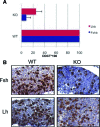Targeted ablation of the WW domain-containing oxidoreductase tumor suppressor leads to impaired steroidogenesis
- PMID: 18974271
- PMCID: PMC2654736
- DOI: 10.1210/en.2008-1087
Targeted ablation of the WW domain-containing oxidoreductase tumor suppressor leads to impaired steroidogenesis
Abstract
The WW domain-containing oxidoreductase (WWOX) gene encodes a 46-kDa tumor suppressor. The Wwox protein contains two N-terminal WW domains that interact with several transcriptional activators containing proline-tyrosine motifs and a central short-chain dehydrogenase/reductase domain that has been suggested to play a role in steroid metabolism. Recently, we have shown that targeted deletion of the Wwox gene in mice leads to postnatal lethality and defects in bone growth. Here, we report that Wwox-deficient mice display impaired steroidogenesis. Mutant homozygous mice are born with gonadal abnormalities, including failure of Leydig cell development in testis and reduced theca cell proliferation in ovary. Furthermore, Wwox(-/-) mice displayed impaired gene expression of key steroidogenesis enzymes. Affymetrix microarray gene analysis revealed differentially expressed related genes in steroidogenesis in knockout mice testis and ovary as compared with control mice. These results demonstrate the essential requirement for the Wwox tumor suppressor in proper steroidogenesis.
Figures




Similar articles
-
Conditional inactivation of the mouse Wwox tumor suppressor gene recapitulates the null phenotype.J Cell Physiol. 2013 Jul;228(7):1377-82. doi: 10.1002/jcp.24308. J Cell Physiol. 2013. PMID: 23254685 Free PMC article.
-
WWOX: its genomics, partners, and functions.J Cell Biochem. 2009 Nov 1;108(4):737-45. doi: 10.1002/jcb.22298. J Cell Biochem. 2009. PMID: 19708029 Review.
-
The WWOX tumor suppressor is essential for postnatal survival and normal bone metabolism.J Biol Chem. 2008 Aug 1;283(31):21629-39. doi: 10.1074/jbc.M800855200. Epub 2008 May 16. J Biol Chem. 2008. PMID: 18487609 Free PMC article.
-
Targeted deletion of Wwox reveals a tumor suppressor function.Proc Natl Acad Sci U S A. 2007 Mar 6;104(10):3949-54. doi: 10.1073/pnas.0609783104. Epub 2007 Feb 27. Proc Natl Acad Sci U S A. 2007. PMID: 17360458 Free PMC article.
-
WW domain-containing oxidoreductase's role in myriad cancers: clinical significance and future implications.Exp Biol Med (Maywood). 2014 Mar;239(3):253-63. doi: 10.1177/1535370213519213. Epub 2014 Feb 7. Exp Biol Med (Maywood). 2014. PMID: 24510053 Review.
Cited by
-
Disorders of sex development: new genes, new concepts.Nat Rev Endocrinol. 2013 Feb;9(2):79-91. doi: 10.1038/nrendo.2012.235. Epub 2012 Dec 18. Nat Rev Endocrinol. 2013. PMID: 23296159 Review.
-
Accelerating Onset of Puberty Through Modification of Early Life Nutrition Induces Modest but Persistent Changes in Bull Sperm DNA Methylation Profiles Post-puberty.Front Genet. 2020 Aug 26;11:945. doi: 10.3389/fgene.2020.00945. eCollection 2020. Front Genet. 2020. PMID: 33005172 Free PMC article.
-
Molecular Functions of WWOX Potentially Involved in Cancer Development.Cells. 2021 Apr 29;10(5):1051. doi: 10.3390/cells10051051. Cells. 2021. PMID: 33946771 Free PMC article. Review.
-
Drosophila orthologue of WWOX, the chromosomal fragile site FRA16D tumour suppressor gene, functions in aerobic metabolism and regulates reactive oxygen species.Hum Mol Genet. 2011 Feb 1;20(3):497-509. doi: 10.1093/hmg/ddq495. Epub 2010 Nov 12. Hum Mol Genet. 2011. PMID: 21075834 Free PMC article.
-
WWOX: a fragile tumor suppressor.Exp Biol Med (Maywood). 2015 Mar;240(3):296-304. doi: 10.1177/1535370214561590. Epub 2014 Dec 22. Exp Biol Med (Maywood). 2015. PMID: 25538133 Free PMC article. Review.
References
-
- Bednarek AK, Laflin KJ, Daniel RL, Liao Q, Hawkins KA, Aldaz CM 2000 WWOX, a novel WW domain-containing protein mapping to human chromosome 16q23.3-24.1, a region frequently affected in breast cancer. Cancer Res 60:2140–2145 - PubMed
-
- Ried K, Finnis M, Hobson L, Mangelsdorf M, Dayan S, Nancarrow JK, Woollatt E, Kremmidiotis G, Gardner A, Venter D, Baker E, Richards RI 2000 Common chromosomal fragile site FRA16D sequence: identification of the FOR gene spanning FRA16D and homozygous deletions and translocation breakpoints in cancer cells. Hum Mol Genet 9:1651–1663 - PubMed
-
- Aqeilan RI, Croce CM 2007 WWOX in biological control and tumorigenesis. J Cell Physiol 212:307–310 - PubMed
Publication types
MeSH terms
Substances
LinkOut - more resources
Full Text Sources
Other Literature Sources
Molecular Biology Databases

